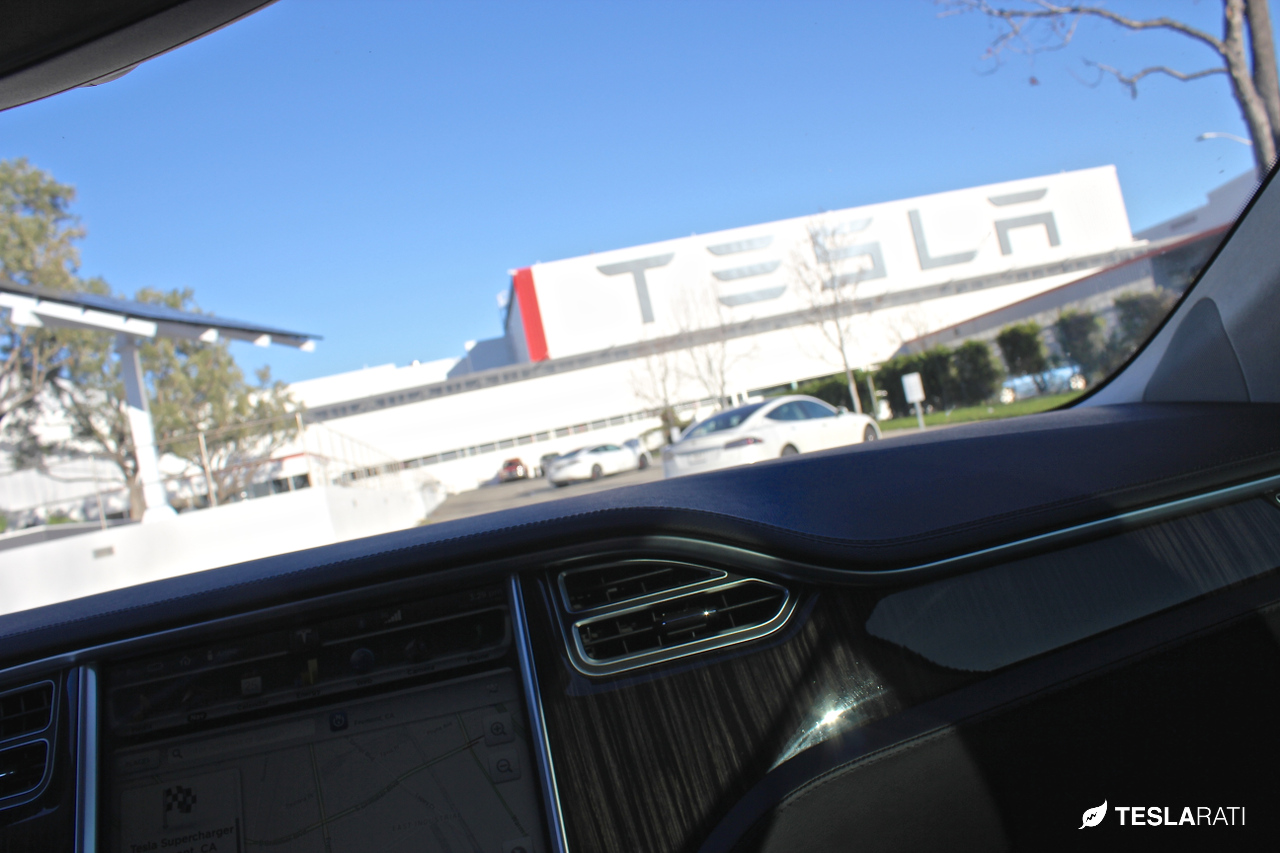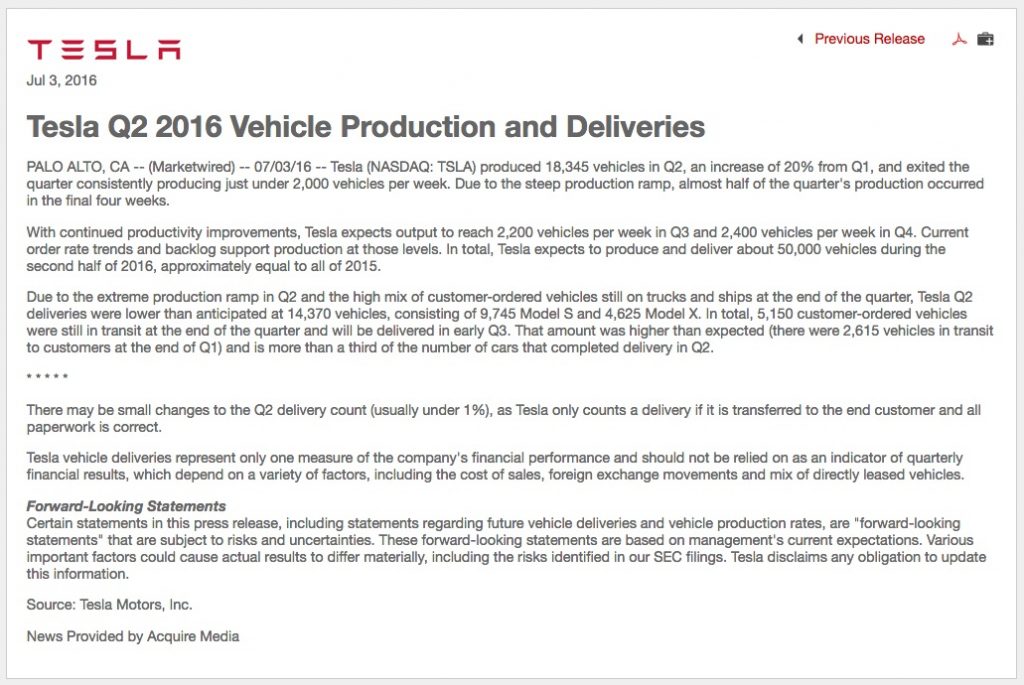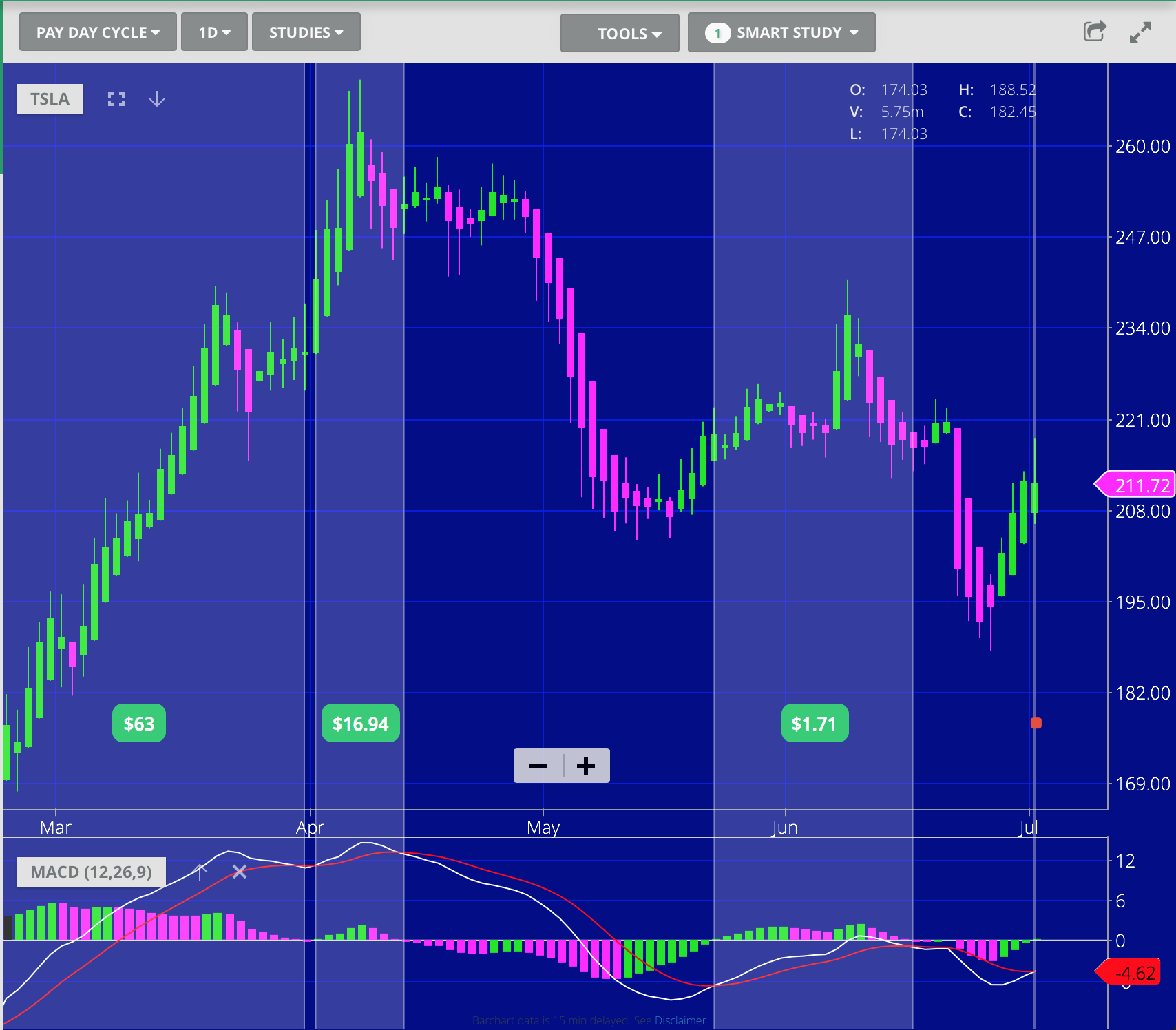Investor's Corner
Tesla increases Q2 production by 20% but falls short of deliveries

Tesla issued its Q2 production and delivery numbers, indicating that the company produced 20 percent more cars this quarter than the previous however fell short in delivering the vehicles to customers.
The Silicon Valley based electric car company reported 18,345 vehicles produced in Q2 or roughly just under 2,000 vehicles per week, and delivered 14,370 vehicles though guidance was set at 17,000 vehicles. Tesla attributed the fact that “Tesla Q2 deliveries were lower than anticipated” to having “5,150 customer-ordered vehicles [..] still in transit, a much higher number than the 2,615 vehicles in transit to customers at the end of Q1.”
Tesla added that half it saw a huge production ramp towards the end of Q2 resulting in half of the quarter’s production occurring in the final four weeks. Model S continues to lead in terms of deliveries consisting of 9,745 units delivered versus 4,625 Model X.

Tesla Q2 2016 Vehicle Production and Deliveries Release [Source: Tesla Investor Relations]
As far as total deliveries for the full year 2016, “Tesla expects to produce and deliver about 50,000 vehicles during the second half of 2016”, which means it will not be able to hit the low end of previous guidance of “80,000 to 90,000 new vehicles in 2016” as the projected 2016 yearly number for 2016 now stands at 79,000.
Tesla Market Action
During the past week $TSLA stock seems to have safely discarded the major bad news about the Model S driver killed while using Autopilot. While the press was flooded with negative articles about the accident (I counted an average of 2-4 articles per day in the Wall Street Journal and on Bloomberg), and the news ended up being reported 2 days in a row in the national news broadcast of all major networks, Wall Street traders shrugged the bad news off completely. While the stock had a temporary drop to 206 in after hours extended trading on Thursday when the news came up on the wire, $TSLA stock shot back with a vengeance to the $216 level on Friday, giving traders one of the best weeks of the year with a whopping 15% weekly gain.
What will $TSLA stock do when the market reopens on Tuesday after the 4th of July holiday? If we look at the response after the Q1 deliveries were reported on April 4, most news outlets reported that Tesla Missed Its Q1 Delivery Targets. Wall Street traders did not care much then, trading the stock up for 3 sessions to an all time high of $266 after the news. In that case, Tesla had reiterated the 80 to 90 thousand deliveries for the year, which may have softened the bad news of total quarterly deliveries.
This is a quick look to today’s headlines in response to the Q2 delivery numbers.
- The Verge: Tesla falls short of delivery estimates in Q2 despite ramping production
- NBC News: Tesla cranks out 20% more cars in Q2, but struggles to deliver them
- USA Today: Tesla deliveries in Q2 fall short of estimates
- ABC News: Tesla Vehicle Deliveries Slip in Q2
Technical indicators were in a really good spot at market close on Friday: 4-days of positive Heikin Ashi charts, MACD positive, MACD averages “pinching”, indication the possible start of a longer breakout on the upside. But the possible bullish breakout could be stopped by the market reaction to what is effectively a “miss” of guidance for the year, more than the smaller numbers for the quarter.
Will Wall Street traders shrug off the Q2 negative results like they did with Q1?

Source: Wall Street I/O

Investor's Corner
Tesla stock closes at all-time high on heels of Robotaxi progress

Tesla stock (NASDAQ: TSLA) closed at an all-time high on Tuesday, jumping over 3 percent during the day and finishing at $489.88.
The price beats the previous record close, which was $479.86.
Shares have had a crazy year, dipping more than 40 percent from the start of the year. The stock then started to recover once again around late April, when its price started to climb back up from the low $200 level.
This week, Tesla started to climb toward its highest levels ever, as it was revealed on Sunday that the company was testing driverless Robotaxis in Austin. The spike in value pushed the company’s valuation to $1.63 trillion.
Tesla Robotaxi goes driverless as Musk confirms Safety Monitor removal testing
It is the seventh-most valuable company on the market currently, trailing Nvidia, Apple, Alphabet (Google), Microsoft, Amazon, and Meta.
Shares closed up $14.57 today, up over 3 percent.
The stock has gone through a lot this year, as previously mentioned. Shares tumbled in Q1 due to CEO Elon Musk’s involvement with the Department of Government Efficiency (DOGE), which pulled his attention away from his companies and left a major overhang on their valuations.
However, things started to rebound halfway through the year, and as the government started to phase out the $7,500 tax credit, demand spiked as consumers tried to take advantage of it.
Q3 deliveries were the highest in company history, and Tesla responded to the loss of the tax credit with the launch of the Model 3 and Model Y Standard.
Additionally, analysts have announced high expectations this week for the company on Wall Street as Robotaxi continues to be the focus. With autonomy within Tesla’s sights, things are moving in the direction of Robotaxi being a major catalyst for growth on the Street in the coming year.
Elon Musk
Tesla needs to come through on this one Robotaxi metric, analyst says
“We think the key focus from here will be how fast Tesla can scale driverless operations (including if Tesla’s approach to software/hardware allows it to scale significantly faster than competitors, as the company has argued), and on profitability.”

Tesla needs to come through on this one Robotaxi metric, Mark Delaney of Goldman Sachs says.
Tesla is in the process of rolling out its Robotaxi platform to areas outside of Austin and the California Bay Area. It has plans to launch in five additional cities, including Houston, Dallas, Miami, Las Vegas, and Phoenix.
However, the company’s expansion is not what the focus needs to be, according to Delaney. It’s the speed of deployment.
The analyst said:
“We think the key focus from here will be how fast Tesla can scale driverless operations (including if Tesla’s approach to software/hardware allows it to scale significantly faster than competitors, as the company has argued), and on profitability.”
Profitability will come as the Robotaxi fleet expands. Making that money will be dependent on when Tesla can initiate rides in more areas, giving more customers access to the program.
There are some additional things that the company needs to make happen ahead of the major Robotaxi expansion, one of those things is launching driverless rides in Austin, the first city in which it launched the program.
This week, Tesla started testing driverless Robotaxi rides in Austin, as two different Model Y units were spotted with no occupants, a huge step in the company’s plans for the ride-sharing platform.
Tesla Robotaxi goes driverless as Musk confirms Safety Monitor removal testing
CEO Elon Musk has been hoping to remove Safety Monitors from Robotaxis in Austin for several months, first mentioning the plan to have them out by the end of 2025 in September. He confirmed on Sunday that Tesla had officially removed vehicle occupants and started testing truly unsupervised rides.
Although Safety Monitors in Austin have been sitting in the passenger’s seat, they have still had the ability to override things in case of an emergency. After all, the ultimate goal was safety and avoiding any accidents or injuries.
Goldman Sachs reiterated its ‘Neutral’ rating and its $400 price target. Delaney said, “Tesla is making progress with its autonomous technology,” and recent developments make it evident that this is true.
Investor's Corner
Tesla gets bold Robotaxi prediction from Wall Street firm
Last week, Andrew Percoco took over Tesla analysis for Morgan Stanley from Adam Jonas, who covered the stock for years. Percoco seems to be less optimistic and bullish on Tesla shares, while still being fair and balanced in his analysis.

Tesla (NASDAQ: TSLA) received a bold Robotaxi prediction from Morgan Stanley, which anticipates a dramatic increase in the size of the company’s autonomous ride-hailing suite in the coming years.
Last week, Andrew Percoco took over Tesla analysis for Morgan Stanley from Adam Jonas, who covered the stock for years. Percoco seems to be less optimistic and bullish on Tesla shares, while still being fair and balanced in his analysis.
Percoco dug into the Robotaxi fleet and its expansion in the coming years in his latest note, released on Tuesday. The firm expects Tesla to increase the Robotaxi fleet size to 1,000 vehicles in 2026. However, that’s small-scale compared to what they expect from Tesla in a decade.
Tesla expands Robotaxi app access once again, this time on a global scale
By 2035, Morgan Stanley believes there will be one million Robotaxis on the road across multiple cities, a major jump and a considerable fleet size. We assume this means the fleet of vehicles Tesla will operate internally, and not including passenger-owned vehicles that could be added through software updates.
He also listed three specific catalysts that investors should pay attention to, as these will represent the company being on track to achieve its Robotaxi dreams:
- Opening Robotaxi to the public without a Safety Monitor. Timing is unclear, but it appears that Tesla is getting closer by the day.
- Improvement in safety metrics without the Safety Monitor. Tesla’s ability to improve its safety metrics as it scales miles driven without the Safety Monitor is imperative as it looks to scale in new states and cities in 2026.
- Cybercab start of production, targeted for April 2026. Tesla’s Cybercab is a purpose-built vehicle (no steering wheel or pedals, only two seats) that is expected to be produced through its state-of-the-art unboxed manufacturing process, offering further cost reductions and thus accelerating adoption over time.
Robotaxi stands to be one of Tesla’s most significant revenue contributors, especially as the company plans to continue expanding its ride-hailing service across the world in the coming years.
Its current deployment strategy is controlled and conservative to avoid any drastic and potentially program-ruining incidents.
So far, the program, which is active in Austin and the California Bay Area, has been widely successful.








